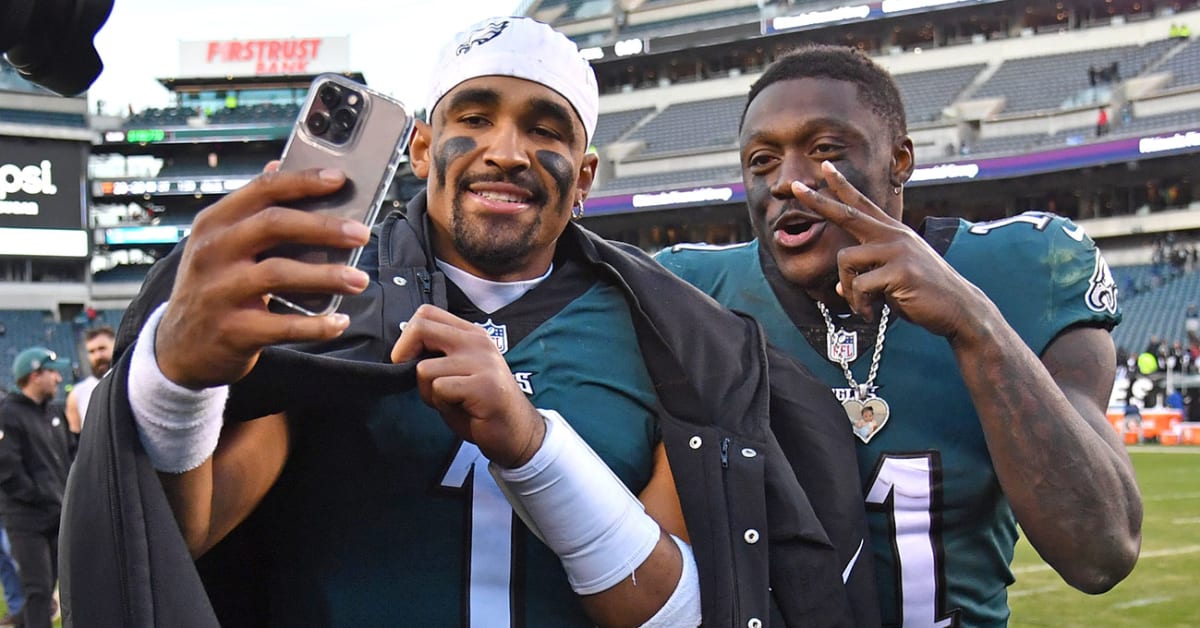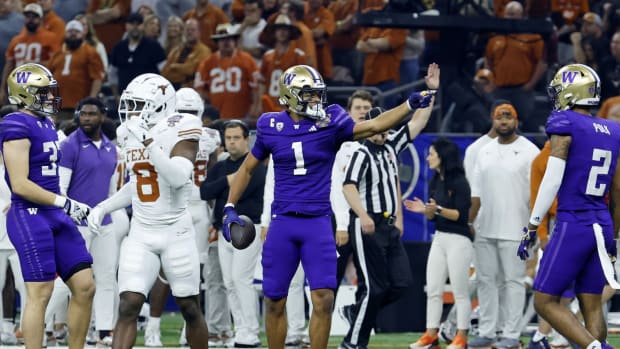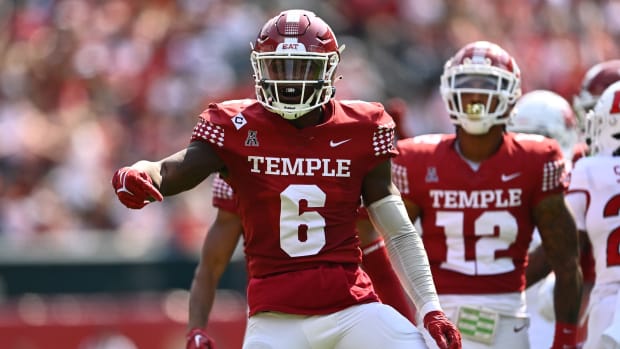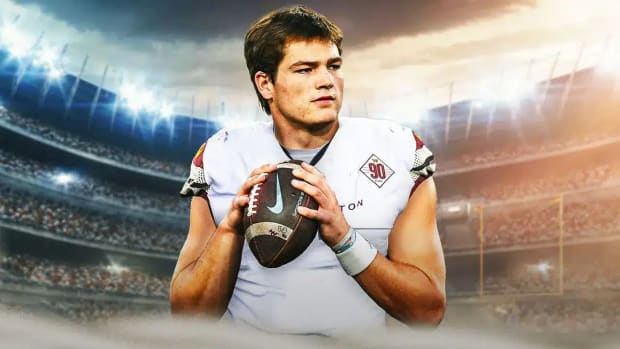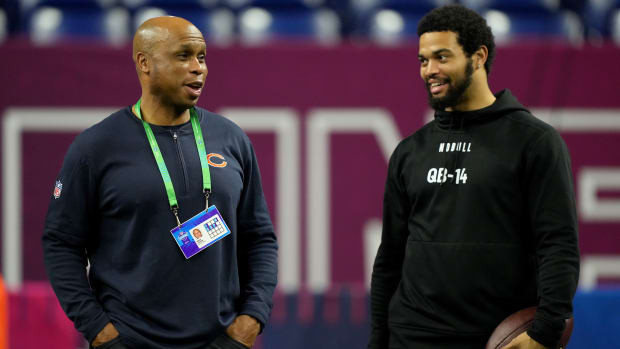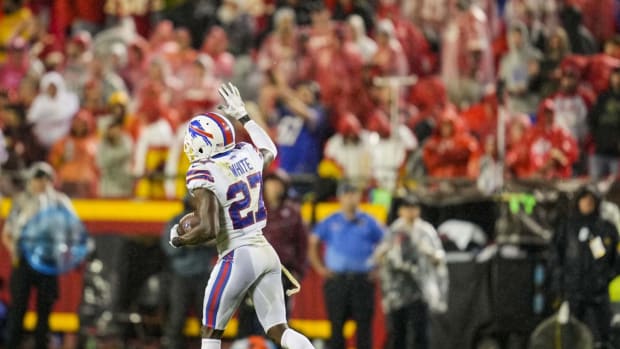Jalen Hurts and A.J. Brown Were Already Best Friends. Then They Became One of the NFL’s Best Duos
As the most deliberate superstar in sports, Jalen Hurts does not weigh in on Eagles personnel decisions. Many a franchise quarterback offer this kind of impact or aspire to help shape the rosters around them. Hurts trusts his general manager, Howie Roseman, and that trust is implicit. But Hurts also broke his own rule once, before the 2022 NFL draft. And his decision, this rare break from the ironclad rules he established and lives by, changed far more than just the trajectory of his career.
Hurts’s welcomed input that spring helped the Eagles land his close friend and kindred spirit, a large-framed, fleet-footed, sure-handed receiver who had excelled in college at Ole Miss and in the pros with the Titans. Hurts understood that A.J. Brown wanted to escape Tennessee, after injuries (to him, not a ton), amid what appeared to be an impending decline (for the franchise overall). They even joked, these friends since they were teenagers, about fashioning a reunion of sorts, one that would unfold, fittingly, in the city of Brotherly Love.
Brown and Hurts are like brothers. Remove the “like” even. Their connection—and shared office space—ranks among the primary factors in the Eagles’ dominance since last season kicked off. Philly wouldn’t have reached the Super Bowl without them and wouldn’t be a league-leading 8–1 this season without them. Proof was stamped by one six-game stretch for Brown, dominance obvious from receiving yardage totals alone in Week 3 through Week 8: 131-175-127-131-137-130. To call that stretch elite, for either of them but Brown especially, undersells. (And Brown added seven receptions for 66 yards and another score, his sixth, in Week 9’s win over the Cowboys.)
Consider Oct. 29, for just one example, an afternoon in which Hurts threw for 319 yards and posted a 135.7 quarterback rating in a win over the Commanders, and Brown snagged eight receptions for 130 yards and two touchdowns. Hurts became the sixth player in NFL history to gain at least 300 yards (passing and rushing) and score at least two touchdowns (same) in six consecutive games. He joined quite a list there: Andrew Luck, Drew Brees, Aaron Rodgers, Patrick Mahomes and Steve Young. Hurts also eclipsed 10,000 career passing yards that Sunday, becoming the fifth QB in league history (with Josh Allen, Kyler Murray, Cam Newton and Russell Wilson) to collect 10,000-plus yards and 2,000-plus rushing yards in their first four seasons.
The friend he pushed Philadelphia to acquire did Hurts one better, with Hurts’s assistance. Never before had an NFL wideout notched six straight performances with at least 125 receiving yards until Brown completed that stretch against Washington. Through nine games, he now has 67 catches for 1,005 yards.
There is, of course, roughly half a season left for both to add to their staggering tallies of statistics. Next up: Kansas City, for a Super Bowl rematch held on Monday Night Football.
Hurts has vaulted Philly to wins in 25 of his past 27 regular-season starts. And yet, while all this might seem expected, the duo had never played together until recently, despite their friendship and its depth. They met as elite prospects of similar ages—Brown, now 26, is the older “brother” by one year—and nearly teamed up in college. Both were freshmen during the 2016 season. But after Hurts committed to Alabama, he lobbied Brown to join him. Lobbied hard, even, his father, Averion Hurts Sr., said last February, involving friends and relatives.
What happened next became part of college football history, no exaggeration necessary. Hurts started early into his time at Alabama, transformed into a superstar, won and lost national title games and became known, in part and not an insignificant one, for his infamous benching at halftime of Alabama’s College Football Playoff triumph. Brown didn’t win as many games at Mississippi, but he sure caught a lot of passes (189 in three seasons), gained a country mile’s worth of yards (2,984) and hauled in 19 touchdowns.
Their paths were interesting that way.
Brown, his attention driven by statistics amassed and NFL potential exuded, at least to outsiders, a wideout who wasn’t winning every game but could, of course, help someone else win them.
Then, Hurts: defined by one moment and everything around it, a winner whom, the skeptics decided, might not succeed in the NFL.
“I couldn’t have done what you did, no way,” Brown once told his brother, a story he relayed to Sports Illustrated last fall in the Eagles’ locker room.
To overcome the benching, to persevere, Hurts often turned to Brown for counsel, an ear, a distraction. “Unwavering,” Hurts’s brother, Averion Jr., says of their friendship during that turbulent stretch. “Just confirmed everything I knew.”
“You know, narratives,” Senior says. He pauses, unable to continue speaking. Instead, it’s ha, ha, ha, haha, hahahahahahahaha, ha, haha, hahaha. The string seems therapeutic; part cackle, part redemption, part vindication and part laugh. But, to be clear, not the last one.
The non-brother brothers understand exactly what that cackle signifies. Brown left Ole Miss with a year of eligibility remaining, declared for the draft and still fell to the middle of the second round in 2019, owing in part to concerns over his top speed. He went No. 51. Hurts transferred to Oklahoma, flourished under then coach Lincoln Riley and went into the ’20 prospect pool, where his presence was … divisive. The Eagles snagged him in the second round as well, to the surprise of everyone, Hurts included.

The duo would like to be in possession of a different trophy at the end of this season.
Bill Streicher/USA TODAY Sports
Philadelphia, behind Roseman’s magic and itchy transaction fingers, transformed its franchise once more through three consecutive drafts. The first—when Brown was drafted—the Eagles had no immediate role in. But had Brown not gone to the Titans, perhaps he would not have been available after three seasons. He was too talented, too accomplished, to ship away so young. Unless, that is, circumstances dictated he should. And, while his circumstances changed, Hurts entered the draft. As pick after pick sped by without the quarterback’s name being announced, he called Brown over FaceTime. He struck his old friend as sad and resolved, not angry so much as determined. “Someone will take you soon,” Brown says he told Hurts.
Where some NFL franchises saw Hurts’s benching and evolving skill set as weaknesses, or reason to drop him down their draft boards, the Eagles saw something else. Potential. Promise. Roseman looked around the league at the best quarterbacks in pro football—Brady, Rodgers, Mahomes and the rest. Hadn’t they all confronted insurmountable obstacles with ease? Didn’t how they surmounted shortcomings, injuries, doubts and all the rest matter?
Hadn’t Hurts proven that ability in college far better than any of them?
“He has this moment, where he gets pushed back and hangs there,” Roseman told SI last February. He smiles a sly smile, then adds, “I can relate to that, you know.”
Roseman always believed in acquiring elite backup quarterbacks with fervency. He had good reasons for that, season after season when the team’s second-best signal-caller played a pivotal role in whatever level of success they reached. “Nobody’s benefited more from that position than the Eagles,” he says. But those benefits came at a high price. Heading into 2020, Roseman wanted to shift the strategy. He would do that by selecting a quarterback, and he even knew which round—the second—because he had dealt his third- and fifth-rounders to the Lions for cornerback Darius Slay.
The general manager who tried to move forward, always, without fear or regret, also knew the exact scenario he wanted to avoid. Back in 2012, he loved a dual-sport QB that many of his counterparts doubted. He planned to take Russell Wilson. He even knew the round (three). When the Seahawks stole his preferred quarterback before Roseman’s turn, he lamented his mistake. That one, he did regret.
Thus, during draft evaluations in 2020, once both Roseman and owner Jeffrey Lurie ascertained the player they wanted, they decided that, no matter what, regardless of value or position needs, they would take him in that Round 2. That player was Hurts. They had dispatched their director of performance, Ted Rath, and others to Alabama to find out everything they could about him. They had studied and evaluated every single pass he threw in college. They did not, counter to popular opinion, simply want Hurts as a running complement to their starter, Carson Wentz. “We were obsessed with Jalen,” Lurie told SI last February. But wanted him because of his upside, Lurie says. “Our only hope was that nobody took him before us.”
After taking wideout Jalen Reagor at No. 21, Roseman found Lurie in the draft room. “Whatever happens here, let’s make sure we get Jalen in the second round,” he said.
The interminable wait began right then, lasting overnight and through most of the next day. The Eagles’ next pick was No. 53. They talked with teams above them about trading up but found no takers. They held their collective breath. Receivers flew off the board, as did safeties and running backs. When the Bears took corner Jaylon Johnson three picks before their turn, Roseman and Lurie loved their chances. Only the Rams and the Cowboys would choose before them, and neither of those teams seemed to hold an obvious need at quarterback. The Cowboys selected corner Trevon Diggs; the Rams, running back Cam Akers.
Lurie nearly fell over in excitement. That morning, he had watched a televised Hurts interview. While his new signal-caller had elements of his game that needed work, specific areas that would require improvement, Hurts’s words confirmed Lurie’s deep-seated beliefs. Philadelphia would make another unpopular decision. Its fan base would react in typical fashion, with loud boos and incredulous expressions and more than a few complaints. But Lurie saw a player who knows “who he is, what he wants to be and where he wants to go.”
The feeling,” he said, “was this guy can be special.”
Right then, Hurts knew none of that. Before hanging up with Brown, his cellphone vibrated. Someone from the 215 area code was calling. Philadelphia. Didn’t they already have a QB? They did, but it didn’t matter. Hurts was the pick, their only option.
After signing with Philly, Hurts traveled to Mississippi to celebrate the second birthday of his goddaughter, Jersee, Brown’s first child, and pride and joy. Brown had asked Hurts to be her godfather; they had grown that close. While hanging with the wideout’s extended family at a cookout, Brown let loose a mighty secret: He might leave Tennessee. They joked about the impossible. Maybe they would play together. Dream on!

Brown and Hurts instantly became one of the top quarterback-receiver tandems in the NFL.
Bill Streicher/USA TODAY Sports
Hurts soon pivoted into defying logic and odds, pushing internally for the Eagles to nab the star who happened to be one of his closest friends. Lo and behold … dreams do come true. On the night of that NFL draft, in 2022, Philadelphia dealt its first-round pick for Brown, who celebrated with his new quarterback and old friend—via FaceTime, of course. Brown arrived at training camp in a HURTS SZN T-shirt.
The wideout lived up to his Instagram handle: @1kalwaysopen_. He transformed Hurts’s career, the Eagles’ offense and the franchise’s fortunes. Not bad work for a single season.
The Eagles built throughout 2022, especially on offense, as all the pieces coalesced into a frightening whole. After their first loss, to Washington in mid-October, the Birds truly took flight. From Weeks 12 to 14, the Eagles scored at least 35 points in three consecutive victories. To DeVonta Smith, the talented wideout who most benefited from Brown’s comic book hero presence, how they won mattered more than anything. That stretch showcased a complete offense and a complete team, he told SI last December. Hurts ran for 157 yards against the Packers. He passed for 380 yards against the Titans (as Brown scored twice against his former team). Against the Giants, as Philadelphia became the NFL’s first team to clinch a playoff berth, he melded both styles, passing for 217 yards and rushing for 77 while scoring three times, good for nine touchdowns in that span.
If their quarterback tied everyone together, their new acquisition amplified everyone Hurts tethered. Brown blocked, opening lanes for running backs and leading fellow targets into end zones. He still called for more targets, friend or not. “Open like clockwork,” Brown commented on a fan’s Instagram post. “Tell a friend to tell a friend.”
In response, consider Brown’s receiving yard totals for the final four games of last regular season: 181, 103, 97, 95. Not bad, but also a mere prelude to this season’s stretch. Brown completed a monster year after the trade, finishing sixth in the NFL with 88 receiving yards per game. In the process, he set a franchise single-season record for receiving yards (1,496).
Typical NFL adjustments suggested that defenses would pay Brown even more attention in 2023. If they have, it hasn’t mattered. His own franchise record is in jeopardy, as he’s 491 away with eight games left.
That doesn’t matter a whole lot to the brothers. Brown wants the ball, lobbies for targets and amasses staggering statistics. But in Philadelphia, at the urging of his comrade, he also does the smaller tasks without complaint. All speak the same thing, an aim they share with unwavering certainty. For the duo amid a glorious reunion of sorts, only championships matter, and they’re still hunting for their first. First of many, they might add.
































